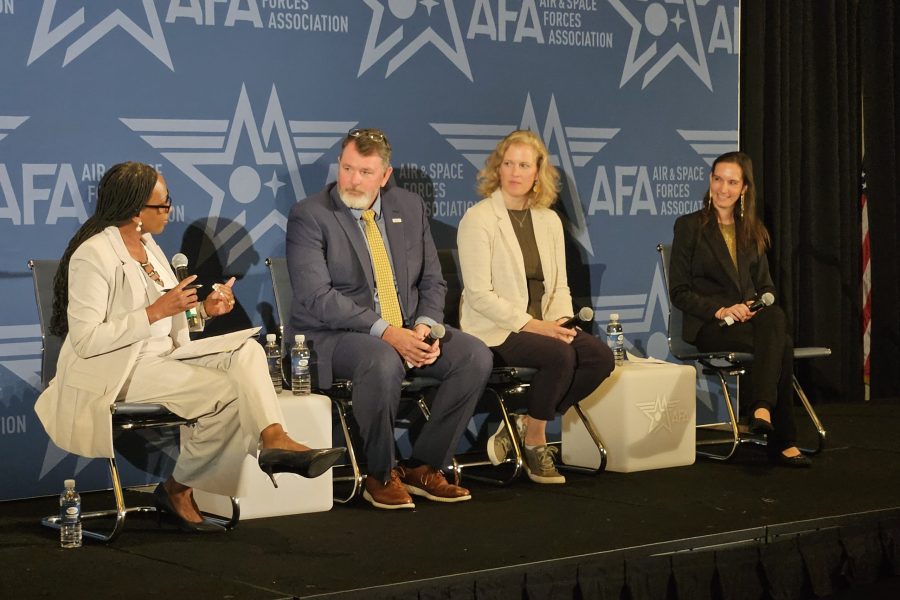NATIONAL HARBOR, Md.—The Air Force and its fellow military services need to stop thinking about cyber as a technology issue and focus on learning how to use it as a weapon of war, the U.S. Navy’s former top cyber advisor Chris Cleary said Sept 16.
“I still think all the services are struggling as to how they’re going to embrace cyber,” Cleary told Air & Space Forces Magazine after speaking on a panel about cyber dominance at AFA’s Air, Space & Cyber Conference.
“You talk about cyber dominance, and people start talking about Zero Trust and what the [Chief Information Officers] do,” said Cleary, now a vice president with defense contractor ManTech. “No. This is about warfighting.”
Earlier, Cleary told the panel, moderated by Department of the Air Force CIO Venice Goodwine, that military cyber operators need to start thinking and talking about the ways that cyber tools could be used to inflict damage on the enemy.
“What is our business?” he asked, “The Department of Defense exists fundamentally for two reasons, to deliver lethality or prevent lethality from being delivered upon us.”
His remarks come as Air Force leaders are publicly grappling with the relationship between cyber and other nonkinetic conflict modes like electronic warfare and information operations. In particular, they are weighing the future of the 16th Air Force, a sprawling Numbered Air Force that encompasses cyber attacks, electronic warfare, traditional surveillance and reconnaissance, public affairs and information operations, and weather forecasting.
Air Forces Cyber is being elevated to the status of a service component command, on part with Pacific Air Forces or Air Forces Central. But that leaves a question mark over the future of the 16th Air Force, since AFCYBER accounts for a significant proportion of its 49,000-strong personnel.
Air Force Secretary Frank Kendall told the conference earlier Sept. 16 that service leaders remain committed to the integration of cyber and electronic warfare in a single command structure: “There must be uniform focus on this (EW) area as a whole,” he said.
As the cyber dominance panel was drawing to a close, Goodwine asked the audience of Air Force personnel and industry contractors to shout out what cyber dominance meant to them. “Winning,” yelled one Airman.
“Thank you,” replied Cleary.
To be taken seriously as warfighters, Cleary explained, cyber operators needed to embrace their role as bringers of death and destruction on America’s enemies. “You are a player on the field, not a support element in the back office, but you have to demonstrate you can hit with power,” he said.
There were still too many commanders who are skeptical of the real utility of cyber capabilities, Cleary said, seeing them as “a parlor trick.”
Commanders need to have confidence that “cyber effects can be delivered at a time and place of our choosing to support other kinetic things that we’re going to do,” he said. Without that confidence, he said, they will “just put a [conventional/kinetic] weapon on that target anyway, just to be on the safe side,” eliminating the potential advantages offered by a non-kinetic option.
The services can help by being more transparent about their offensive cyber capabilities, especially if they want proper funding from Congress, he said. “You can’t say you need $1 billion and then when they ask what for, tell them: ‘I can’t discuss that,’” he said.
Those who want a public discussion of U.S. offensive cyber capabilities are treated “as if they’d taken a crazy pill,” he added.
Cleary argued that classification issues shouldn’t be a barrier to public messaging about offensive cyber capabilities.
“I can tell you about the Columbia class submarines the Navy is building. I do not know how deep it can go, how quiet it is, or the range, yield or accuracy of its weapons. But I know it goes underwater, I know it’s probably quieter than the last one, and I know it carries nuclear warheads,” he said. “And I know how many we’re building and when they’ll be delivered. None of that has to be secret.”

